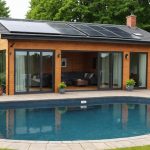Gardening is a cherished part of the British lifestyle, often seen as a meditative retreat and a space to connect with nature. With environmental consciousness on the rise, sustainable landscaping is emerging as a popular trend in UK suburban homes. This article will explore the latest trends in sustainable landscaping, focusing on how you can transform your home garden into a thriving, eco-friendly sanctuary.
1. Maximising the Use of Small Spaces
Urban living often comes with the challenge of limited outdoor space. But with the right design and plants, even the smallest gardens can be transformed into lush, green havens.
A voir aussi : What’s the most efficient layout for a UK home’s utility room in terms of space and ergonomics?
One trend to watch out for in sustainable landscaping for small gardens is vertical gardening. Planting upwards instead of outwards not only saves valuable ground space but also provides a unique aesthetic. You can create a vertical garden by repurposing old pallets or ladders or by installing wall-mounted planters.
Another idea to optimise small garden spaces is to use multi-functional furniture. Consider benches that double up as storage boxes or tables that can transform into plant stands.
Lire également : How can you install underfloor heating in a UK terraced house with wooden floors?
2. Growing Urban Food Gardens
There’s no denying the surge in popularity of homegrown food. With the uncertainties of the global food supply chain, more and more suburban homes are turning their gardens into mini food production areas.
Growing your vegetables and herbs isn’t just a sustainable way of sourcing food; it’s also incredibly fulfilling. Start with easy-to-grow crops like tomatoes, beans, or herbs. Raised beds and containers work well for urban food gardening, especially if the area isn’t suitable for ground planting.
Also, remember that companion planting is a great way to maximise your yield and keep pests at bay. Look for plant pairings that work well together, such as tomatoes and basil or beans and marigolds.
3. Integrating Biodiversity and Wildlife
Another emerging trend in sustainable landscaping is the move towards gardens that support local biodiversity. By choosing native plants, you can provide a habitat for local insects, birds and other wildlife.
Creating a pond or installing a bird bath is a brilliant idea to attract wildlife. You can also consider building a bug hotel or leaving a pile of logs or stones in a corner of your garden. These will create safe spaces for insects, small mammals and amphibians.
Avoid using chemical pesticides and fertilisers, which are harmful to both your plants and the creatures that visit your garden. Instead, choose organic alternatives or, better yet, make your homemade compost.
4. Incorporating Sustainable Materials and Practices
In line with the drive towards sustainability, there’s been a shift towards using eco-friendly materials in garden design. Repurposed wood, recycled plastic and reclaimed metals are all popular choices for garden furniture and structures.
Likewise, water conservation is a critical aspect of sustainable landscaping. Collect rainwater in barrels for watering plants, and consider installing a greywater system to reuse household water. Drought-resistant plants are a great option if water is scarce.
Solar-powered garden lights are another sustainable feature you can add to your garden. Not only do they save energy, they also create a beautiful ambiance in your outdoor space at night.
5. Embracing Permaculture Principles
Finally, permaculture principles are gaining traction in the world of sustainable landscaping. This holistic design philosophy aims to create productive and sustainable gardens and landscapes by mimicking natural ecosystems.
In practice, this could mean creating a ‘food forest’ with layers of trees, shrubs, and ground cover plants that support each other and share resources. Or it could involve implementing a ‘no-dig’ gardening technique to preserve soil structure and promote healthy plant growth.
Permaculture also encourages the use of local resources and waste recycling. Whether it’s composting kitchen scraps or building a garden fence with fallen branches, every aspect of a permaculture garden is designed to be sustainable and self-sustaining.
In summary, sustainable landscaping is about more than just creating a beautiful garden. It’s about designing outdoor spaces in a way that benefits the environment, supports local biodiversity, and creates a healthy, productive space for you to enjoy. With these trends in mind, you can transform your suburban home into a thriving example of sustainability.
6. Transforming Hard Landscaping into Green Areas
In recent years, the notion of hard landscaping has been redefined and is now considered a major aspect of sustainable landscaping. More homeowners are shying away from traditional concrete and paving, seeking softer, greener alternatives for their outdoor spaces.
Gravel, pebbles or bark can be used to create an attractive and permeable surface for driveways and paths. For a greener option, consider grass paving. This innovative solution, offered by companies like Daniel Moquet, combines the strength of hard landscaping with the beauty of a green lawn.
For patios and seating areas, consider using sustainable materials such as reclaimed stone, recycled composite decking or FSC-certified wood. A garden carpet made of ground-covering plants is another attractive and eco-friendly alternative.
Green roofs and living walls have also gained traction in urban areas. They do not only add an aesthetic touch but also provide insulation, absorb rainwater and create habitats for wildlife.
Remember that the choice of hard landscaping materials can significantly impact the sustainability of your garden. Therefore, it’s essential to carefully consider the environmental impact of the materials you choose.
7. Rethinking Lawn Spaces for Sustainability
For many, a manicured lawn is the epitome of a suburban garden. However, traditional lawns require a significant amount of water, fertilisers and maintenance, making them less than ideal from a sustainability perspective.
Instead, consider converting part or all of your lawn into a vegetable garden. This will not only reduce your reliance on the global food production chain but also provide you with fresh, organic produce right at your doorstep.
For those still wanting a lawn, opt for slow-growing, drought-tolerant grass species or a mix of clover and grass. Clover lawns are low-maintenance, rich in nitrogen and attract beneficial insects like bees.
Replacing some lawn areas with native wildflower meadows is another trend gaining popularity. These mini meadow patches can dramatically increase biodiversity in your garden, providing essential food and habitat for bees, butterflies and other insects.
Conclusion: A Vision for Future Home Gardens
The latest trends in sustainable landscaping represent a significant shift in how we view and use our home gardens. It’s no longer just about having an attractive outdoor space; it’s about creating a garden that contributes positively to the environment and local ecosystems.
By embracing practices such as vertical gardening, urban food production and permaculture principles, homeowners can make the most of their small garden spaces. Likewise, by integrating biodiversity and wildlife, using sustainable materials and rethinking lawn spaces, they can transform their gardens into thriving, eco-friendly havens.
The image credit of sustainable landscaping is no longer confined to the realm of specialist gardeners or eco-enthusiasts. It’s increasingly becoming inherent in the way we approach garden design and outdoor living.
As we move further into the 21st century, these trends are likely to continue and evolve. Homeowners will seek new ways to make their gardens more sustainable, tapping into innovative solutions to make their outdoor spaces work harder for them and the environment.
In essence, sustainable landscaping is about striking a balance between functionality, aesthetics and ecological responsibility. By adopting these practices, every single family can play their part in promoting sustainability, right from their backyards.











